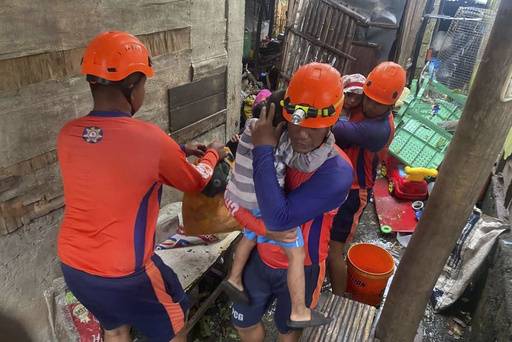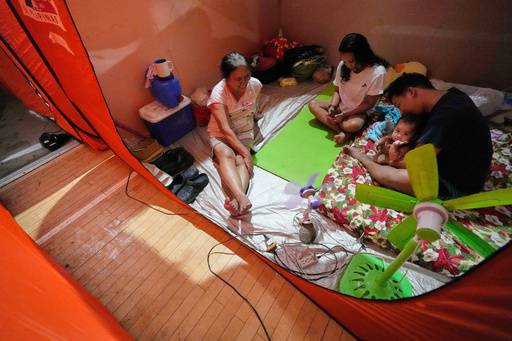Almost 1M evacuated as ‘Uwan’ slams Luzon

Almost 1 million people across Luzon and the Visayas were preemptively evacuated as Supertyphoon “Uwan” (international name: Fung-wong), whose 1,800-kilometer reach spanned almost the entire Philippines, continued to pose “life-threatening” effects, authorities said on Sunday.
Six areas in Luzon were placed under Tropical Cyclone Wind Signal No. 5, based on the latest typhoon bulletin of the Philippine Atmospheric, Geophysical and Astronomical Services Administration (Pagasa). They are the southern portion of Quirino, southeastern portion of Nueva Vizcaya, northeastern portion of Nueva Ecija, central portion of Aurora and Polillo Islands.
The typhoon also claimed two fatalities, according to initial reports including by the City Disaster Risk Reduction and Management Office. A 64-year-old woman named “Faye” of Catbalogan City, Samar, died on Sunday morning after she was pinned by debris from her house, and a villager drowned in flash floods in the island province of Catanduanes.
Samar was among the localities in Eastern Visayas that lost power and communication due to Uwan before noon Sunday.
The Department of the Interior and Local Government (DILG) and the Philippine National Police reminded the public on Sunday that local government units and the police may enforce mandatory evacuations of residents who refuse to leave high-risk areas.
“All means of persuasion must be used to convince residents to move to safer ground. Explain clearly that evacuation is a measure to protect lives, not to take away their rights or property,” the DILG and PNP’s joint statement read.
“Ensure that transportation, shelter, food, and medical aid are ready for evacuees, with priority for the elderly, children, and persons with disabilities,” it continued.
The two agencies called on local authorities to “act quickly and humanely” to prevent casualties during the supertyphoon’s onslaught.
The Catholic Church has also mobilized its parishes and institutions across Metro Manila and the Bicol Region to serve as temporary shelters for those displaced.
In separate announcements on Sunday, the Archdiocese of Manila, Archdiocese of Caceres, Diocese of Kalookan, and Diocese of Virac directed all parishes, schools, and church facilities under their jurisdictions to open their doors to evacuees.
Office of Civil Defense (OCD) Deputy Administrator Bernardo Rafaelito Alejandro IV said, as of 11 a.m. on Sunday, a total of 916,863 individuals, equivalent to 270,682 families, were evacuated in the Cordillera Administrative Region, Ilocos Region, Cagayan Valley, Central Luzon, Calabarzon, Mimaropa, Metro Manila, Bicol Region and the Visayas.
The highest number of evacuees was recorded in the Bicol Region with 660,720 individuals, or 192,765 families, Alejandro said.
This was followed by Eastern Visayas with 112,760 individual evacuees, or 32,020 families; and Calabarzon with 74,388 individuals or 24,209 families.
The OCD also said over 50,000 personnel were on standby for search-and-rescue operations from the Armed Forces of the Philippines, the Philippine National Police, the Philippine Coast Guard, the Bureau of Fire Protection and the Reactionary Standby Support Force.

Massive floods
As early as noon on Sunday, the island-province of Catanduanes in Bicol, where the typhoon passed closely, reported massive floods, particularly in Pandan town, and downed power and communication lines. Many roads in the province were also rendered impassable.
Flooding was also reported along coastal roads in Zambales at noon on Sunday as seawater was whipped by strong winds.
The prohibition on sea travel stranded hundreds of passengers and vehicles in the ports of Masbate, Albay, Sorsogon, Samar, Camarines Sur, Quezon, Marinduque and the Mindoro provinces.
Areas as far as Zamboanga City also reported the evacuation of 1,290 families, or 4,047 individuals from several barangays submerged in water, the Zamboanga City Disaster Risk Reduction and Management Office, told the Inquirer.
Landfall
The number of evacuees was expected to go up as Uwan continued to bring rains and strong winds. According to Pagasa, it was last spotted 110 km north of Daet, Camarines Norte, or 150 km east northeast of Infanta, Quezon, while moving west-northwestward at 30 km per hour (kph). It carried maximum sustained winds of 185 kph near the center and gustiness of up to 230 kph.
Pagasa said Uwan was projected to continue moving west-northwestward for the next 24 hours, passing close to the Polillo Islands before making landfall over the central portion of Aurora on Sunday night or Monday early morning.
“Due to its proximity and the size of its eyewall, a direct hit (i.e., eyewall affecting the area without making landfall) over Calaguas and Polillo Islands is likely,” Pagasa said.
After making landfall, Uwan was expected to traverse over northern Luzon before emerging over the Lingayen Gulf or the coastal waters of Pangasinan or La Union by Monday morning.
“The interaction with the terrain will cause Uwan to weaken significantly, but it is expected to remain as a typhoon throughout its passage over northern Luzon,” Pagasa said. —REPORTS FROM ZACARIAN SARAO, KEITH CLORES, JOEY GABIETA, DELFIN T. MALLARI JR., MA. APRIL MIER-MANJARES, TONETTE OREJAS, YOLANDA SOTELO, HAZEL P. VILLA, JOEY MARZAN, MADONNA VIROLA, LEAH AGONOY, PNA AND AP





















